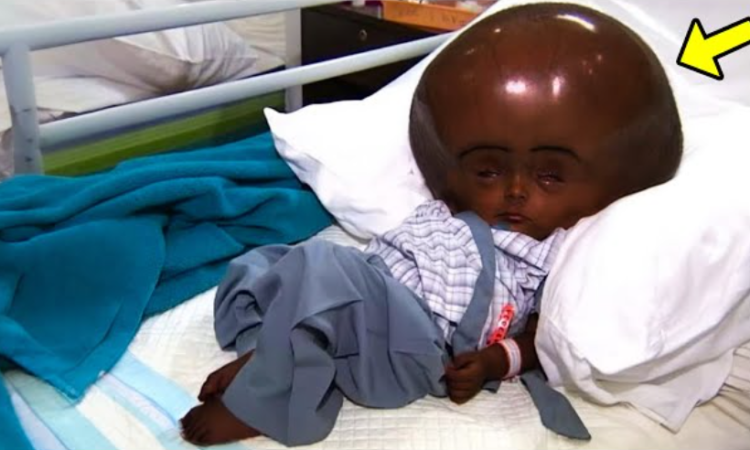
When Runa Begum was born in India in 2011, her head was three times the size of a normal baby’s head, making international headlines. This special child fought bravely for her life, but five years later, something shocking happened that shattered her family.
On a sunny day in 2011, the staff at the small hospital in the remote parts of northeastern India faced an enormous medical challenge. The medical practitioners in the village of Jirania Kala in Tripura had never delivered a child with hydrocephalus before. Little Runa Begum surely looked like someone out of this world. In fact, if they had to honestly describe this baby girl, they would have called her features alien-like. How could they even explain to her parents that their baby girl had little chance of survival, let alone living any kind of normal life?
Although they could not determine the full extent of her abnormality, it was already well known that the buildup of excess cerebrospinal fluid around the brain and spinal cord causes children to be born with an unusually large head, a bulging fontanel, and prominent scalp veins. In these cases, the eyes are usually deviated downwards, with symptoms like vomiting and seizures associated with this devastating condition. As the Begums stood there beside their daughter, experts measured her head circumference to be 94 cm, or 37 inches. Although the size of a baby’s head at birth differs vastly because of various genetic factors, the average circumference of a healthy baby’s head is about 34 cm, or 15 inches.
Her father could see her suffering as little Runa cried constantly because of the excruciating pain the swelling was causing. The doctors were quite blunt when they informed the parents that it would almost be best to just allow their daughter to die in peace. But Fatima and Abdul Begum were not ready to give up the fight. Although their baby was clearly sick and struggling for breath, they knew in their hearts they would simply not surrender her to the jaws of death without trying to do everything in their power to save her life.
The parents of little Runa were poor and couldn’t pay to ask for another medical opinion on their daughter’s case. Abdul worked for a mere daily wage while Fatima was a homemaker without any opportunities for gainful employment. Putting food on the table was a challenge all on its own, and saving enormous amounts of money to pay for expensive hospital treatments was simply impossible for this family. Thankfully, social media has proven to be an excellent tool to highlight a plight to the world in an attempt to find a miracle solution in an otherwise desperate situation.
Eighteen months later, photographers stumbled upon the baby with the enormous head and shared her pictures with the world. The size of this baby’s head made it impossible for her to even sit upright. If nothing was done, she would be confined to a bed with her head on a pillow for the rest of her life. Two Norwegian students, named Natalie Kon and Jonas Borchgrevink, made it their quest to raise money for this troubled child. When people saw her desperate condition, they could not help but respond. An impressive amount of about $62,000 USD was raised, which at the time roughly translated to about 4 million rupees.
The condition of Runa Begum was so unique that her birth and life soon made international headlines. Soon enough, the Fortis Hospital in New Delhi offered to take full responsibility for Runa’s treatment. Surgeons planned to decrease the head circumference from 37 inches to no more than 23 inches, which was still quite large for a baby’s head. During this first operation, doctors drained around 10 liters of excess fluid from the little girl’s brain cavity.
With Runa suffering from a serious medical condition, her parents were extremely concerned about having a second child. Still, the family was delighted to welcome a completely healthy little boy into their intimate circle. A short while after the first operations were done successfully, little Akram and Runa bonded in the way all other siblings do and played together without ever resenting each other.
In the next four years, the inside of Delhi Hospital became all too familiar for the Begum family. Runa spent a total of 105 days in the hospital, being operated upon at least eight times in an attempt to reduce the size of her head. The doctors merely tried to relieve pressure on the brain, but Fatima and Abdul firmly believed that these surgeries would kickstart their child’s development.
They hoped that she would be able to start walking, develop speech, be able to eat unassisted, and eventually even go to school. They were confident that she would one day live a more normal life. But with each operation, there was a profound possibility that Runa might die during surgery. The hospital had to keep the expectations of the parents realistic.
But for a while, life seemed to smile upon this family. After the first two operations, Runa was able to laugh, smile, and turn her head all on her own, and she even started reacting to her name when someone called her. To many, this may not sound like much, but to her desperate parents, each little milestone was a beacon of hope. The neurosurgeon who was involved with the operations was totally surprised at the fighting spirit his little patient displayed. He did not anticipate the amount of improvement she started to show. She even mastered speaking a few words, something he had never expected her to be able to do. She also started gaining weight, which was an excellent sign for any future medical procedures.
The day Runa crawled for the first time in her life was one of the biggest milestones this family could ever hope for. The doctors were simply shocked by her resilience. In all honesty, none of them had expected Runa Begum to live for so long. Initially, she had been given a few days to live, and her parents had been advised to simply let her die. Later on, the doctors had cautiously told the family that she might be lucky if she celebrated her first birthday. But time simply flew by, and Runa achieved the incredible milestone of turning five. Her family was very happy that she was alive and well, and improving her skills every day, even though the steps were extremely tiny.
By this point, the doctors at the Delhi Hospital had already scheduled the next operation for head surgery. The family was prepared for the surgery months in advance, just like every other time. Each time, they had to be informed of the possibility that their daughter might die, and they had to sign a waiver to legally acknowledge it. Despite the risks, the parents also knew that there was no other way for their little girl to even hope for a good quality of life without these operations, so they prepared for another long stay at the local hospital.
But without any specific reason, Runa started experiencing some breathing problems. This wasn’t completely unusual, as the family was used to their little girl fighting for every day she wanted to live. More than once, she had fought her way back from the claws of death. Little did the family know that this time would be completely different.
Abdul had gone off to work, and Fatima was looking after her girl as usual. She saw that Runa was struggling to breathe and did all she could to help her. She had eaten a meal earlier in the day, and everything seemed fine. The onset of this breathlessness was sudden and severe. Fatima made contact with her husband and asked him to rush home. She knew that Runa had to get to the hospital as soon as possible.
When Abdul arrived home, he rushed to his daughter’s side. When he touched her and shook her to get a response, she lay there completely motionless. He was too late—she was already gone. On Sunday, June 18, 2017, Runa lost her desperate fight against a rare condition, just a few short weeks before another surgery. Some members of the community insensitively said that her death was for the better, as she never had a high quality of life.
However, the hearts of her family were torn to pieces. Her little brother was forced to come to terms with the concept of death way before any child should and was devastated to realize that his special sister would never play with him again.
Fatima could barely speak. She had never had any other dream besides being a mother and caregiver for her two children and the wife for Abdul, but now she found herself daughterless. She felt like she had lost any sense of purpose. It was extremely difficult to pick up the pieces of her life and go on, but she still had to fight for the family she still had.
However, she would not let her little Runa’s story be forgotten. A documentary film about her life that is soon to be released will keep her memory alive. Runa might be gone, but her legacy will survive forever.




